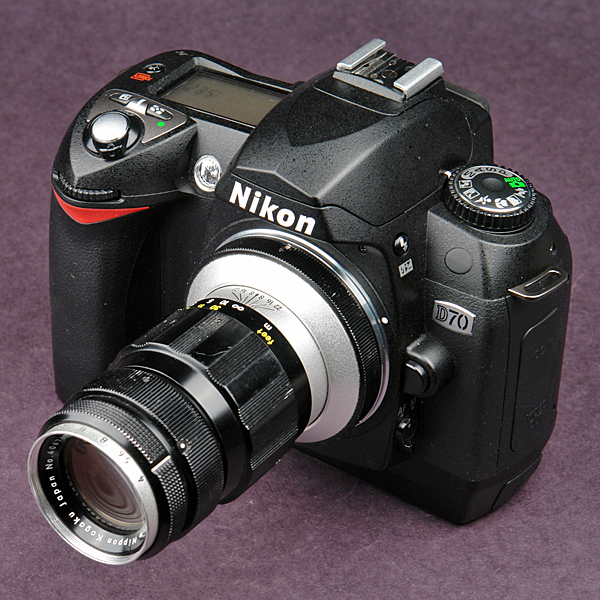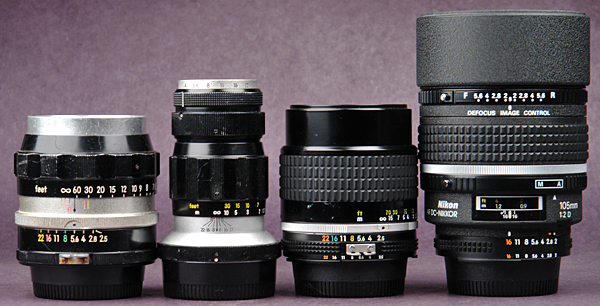Nikon Nikkor-T 10.5cm f/4: Nikon's Unique 105
| Images here are used to illustrate some characteristics of a lens rather than showing my personal artistic point of view. |
The Nikon 105 was a very well-known SLR lens in the film era and is the synonym of the Nikon 105mm f/2.5. Nikon made this SLR lens for more than four decades with only two major types, the Sonnar (early) type and the Double-Gauss (later) type. Most manufacturers prefer to make the 90mm or 100mm versions and Nikon is one of the very few lens makers choosing to go with 105mm.
Nikon launched the 105mm f/2.5 in 1959 for Nikon F, followed by 105mm f/4, 105mm f/1.8 and 105mm f/2 DC. Even the micro lenses are also 105mm, namely 105mm f/2.8, 105mm f/4, Bellow Nikkor 105mm f/4 and UV Micro Nikkor 105mm f/4.5. In fact, only the cheap Nikon 100mm f/2.8 Series E is in 100mm. By the way, the Series E 100mm f/2.8 is a very capable lens.
The fame of the 105 was more or less due to the Vietnam War era correspondents, who found the 105mm f/2.5 to be a cheaper and very capable short telephoto portrait lens. Personally, I always felt that the 105mm performs better than the 135mm and am not used to the 85mm. As a result, right after I started playing with SLRs, I chose the 100mm and 105mm as my standard portrait lens. Throughout the years, I acquired the 105mm (not the micro versions) one after the other; but, I had never thought about the Nikkor-T 105mm f/4 because its performance is not as good as the 105mm f/2.5 and because it has a smaller aperture of f/4 rather than f/2.5, f/2 or even f/1.8.
Since the entire Nikon 105 system includes so many lenses each of which also has a number of variations, it is very difficult to discuss all 105mm lenses in one article. So, I chose to start in a modest way with this uncommon Nikkor-T 10.5cm f/4 and leave other 105mm versions to future articles.
Of these lenses, the most puzzling one is the Nikkor-T 10.5cm f/4, which was produced in March 1960. The well-known Nikkor-P 10.5cm f/2.5 is able to perform the AUTO function even in its first version. The AUTO function, in Nikon's terminology, means that the aperture is always open for focusing and metering and automatically closes down to the shooting aperture when the shutter release button is pressed down to take a photo. If Nikkor-P 10.5cm f/2.5 is such a capable lens, why did Nikon make a smaller aperture 10.5cm without the AUTO function? The full story may never be known. Maybe Nikon just wanted to make a cheaper but high quality lens that performs similarly on RF and SLR cameras. Or, maybe Nikon had learned something from Leica Elmar 105mm f/6.3 (usually referred to as the Mountain Leica). At least, some Leica fans believe this is perhaps the story. However, since the Mountain Leica is a pre-war short-lived product (1932-1937) and Nikkor-T 10.5cm f/4 is a post-war lens, comparing Nikkor-T 10.5cm f/4 against Mountain Leica seems to be a bit far-fetched. Maybe we should compare Nikkor-T 10.5cm f/4 with Leica's Elmar 90mm f/4, a well established lens for several decades. As a matter of fact, due to the success of the Nikkor-P 10.5cm f/2.5, Nikkor-T 10.5cm f/4 survived on the market for only three years, even shorter than that of the Mountain Leica. This explains why Nikkor-T 10.5cm f/4 is not easily found.
The first image below shows three lenses, from left to right, Nikkor-P 10.5cm f/2.5, Nikkor-T 10.5cm f/4 and Leica Elmar 90mm f/4. The second image shows the two 10.5cm lenses.


Each of the non-zoom lenses announced in 1959 has a letter appended to Nikkor-. This letter indicates the number of glass elements used in the lens construction as shown in the table below. Therefore, Nikkor-T 10.5cm f/4 means this lens uses three glass elements, a very typical Triplet design.


The left image below has the inner front rim. It shows that this lens has three glass elements and focal length of 10.5cm with maximum aperture f/4. The right image below shows the aperture range being f/4 to f/22.

The Nikkor-T 10.5cm f/4 uses two rings to set aperture. The ring right below the aperture markings has a white line. Turn that ring so that the white line aligns with the f-value to be used, f/8 in the left image below. This sets the shooting aperture; but, the aperture blades do not close down at this point. The second ring has a small white dot and is used to close down the aperture blades. The right image below shows the aperture blades are closed down to f/8. Therefore, the user sets the aperture to be used with the first ring for focusing, and before shooting the user closes down the aperture to the set aperture with the second ring for metering and focusing. Note that the small white dot can stay at any position and cannot be moved passing the position set by the white line. This means that even though the user may set the aperture to f/8 with the first ring, s/he may use a larger aperture than f/8 set by the white line. The aperture ring has half-stop clicks, but the user may stop anywhere between two clicks. Furthermore, pulling the first ring downward (toward the rear of the lens) and turning it cause both aperture rings to turn simultaneously and at the same time changes the shooting aperture.

The following image below shows an early Nikkor-P Auto 105mm f/2.5 on the left and a Nikkor-T 10.5cm f/4 on the right. It is easy to see the following differences:

Here is the Nikkor-T 10.5cm f/4 mounted on a Nikon D70. The lens looks small.


f/5.6

f/8

f/11

f/16

In my opinion, color rendition of the Nikkor-T 10.5cm f/4 is in the cold side and not very saturated. This could be a combined result of the lens and the Nikon D70. Contrast is also a bit low, especially that flare can show up at f/4 perhaps due to internal reflection. Increasing the image contrast and saturation in post-processing may be very helpful.


In the following two images, contrast is still not high and color rendition is on the "light" side.


It was autumn and rainy while writing this article. Eventually, the sun showed up for a few moments for me to snap some images of autumn leaves. Color rendition is still on the "light" side.








The following shows four more examples. A common characteristic is that a small aperture lens could not dissolve overlapping out of focus spots enough to produce a silky smooth background. In the first and third images, the out of focus spots overlap but are not dissolved sufficiently, and, as a result, the background looks a bit distracting. The fourth shares the same characteristic. The third image has a slight double-line effect around the outline of the out of focus house.




Nikkor-T 10.5cm f/4 lens was not multi-coated and easy to produce flare. In the image below, the sun is located at the upper right corner and is outside of the image. Except for the lower right corner, most area in the image is affected and has lower contrast.

In my opinion, at f/4 the Nikkor-T 10.5cm f/4 is not as good as the Nikkor-P 105mm f/2.5. Image quality between f/5.6 and f/11 is quite uniform. I am not sure if this is only me, but I do feel the Nikkor-T 10.5cm f/4 paired with Nikon D70 always produced colder color and lower contrast. Some believe this may be due to internal reflection, but I do not have a solid proof if this is the main cause. Even at a small aperture, say f/8, this this lens still produced slightly washed out results just like the Meyer Trioplane 100mm f/2.8. On the other hand, the 3-element Leica Elmar 90mm f/4 seems to be better or much better. Anyway, more testing may be needed to find out the cause.
To many SLR/DSLR users, this lens requires some getting used to because the way of setting aperture and the way of metering. Once you become familiar with to these operational issues, the Nikkor-T 10.5cm f/4 can be a very competent company for casual shooting as it is light and small.
Finally, if you love to playing or collecting legacy lenses, the Nikkor-T 10.5cm f/4 may be a good choice. Otherwise, if you just admire the name Nikon 105 and wish to have a 105 to shoot portraits, I would think you should get a AI-S version of the 105mm f/2.5 because of lower price and higher quality. If you wish to use the best of the 105s, you'd better be prepared to spend more money on a AF-D 105mm f/2 DC because it will not let you down. To sum up, as long as optical quality and price are major concerns, the AI-S is the preferred version of the 105mm f/2.5. As for collecting, the RF version of the Nikkor-T 10.5cm f/4 (with hood , lens cap, filters, case, etc.) should be a good choice. Otherwise, this F-mount Nikkor-T 10.5cm f/4 should be OK. If you have a limited budget, the Nikon 100mm f/2.8 Series E is undoubtedly the best choice, because it is cheap and has respectable quality.
The image below shows four Nikon 105 lenses. From left to right, they are the earliest Nikkor-P 10.5cm f/2.5 (1959, the tick-mark version), the Nikkor-T 10.5cm f/4 (1960), the AI-S 105mm f/2.5 (1981), and the AF-D 105mm f/2 DC (1993):



You are visitor
since June 5, 2014
Created: June 5, 2014
Last update: June 5, 2014